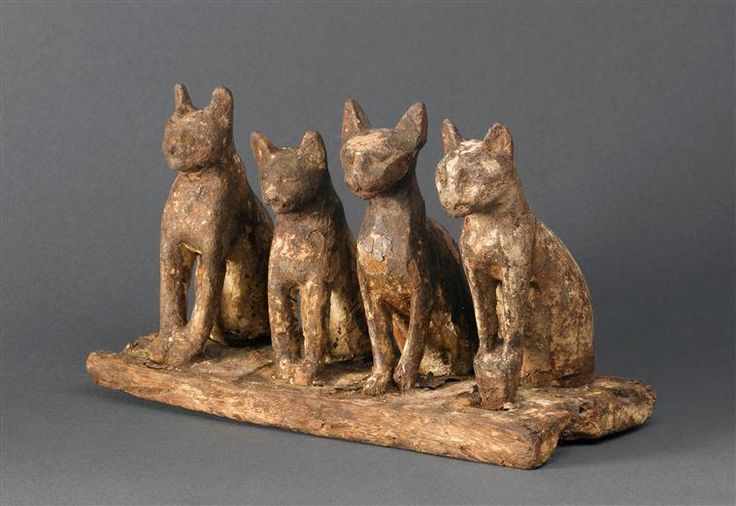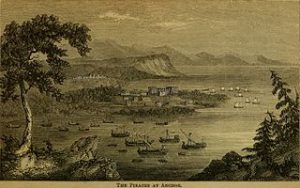Bastet, also known as Bast, was an ancient Egyptian goddess who originally had the role of protecting the Pharaohs. The inhabitants of the lower Nile depicted Bastet as a savage, lion-headed deity. After 1000 BCE, the Egyptians altered her image to the body of a woman and the head of a domesticated cat. Along with her change in appearance, she was also transformed into a peaceful and approachable deity. Instead of Bastet protecting Pharaohs, she was now a nurturer and protector of all households. Families soon began to invite cats inside their homes, thinking that they brought with them the spirit of Bastet. They worshiped these cats because they also hunted mice, snakes, and other pests that ruined their crops and their perishable goods. Bastet’s role as a goddess was further altered when she acquired the trait of fertility. Women would purchase pendants with Bastet and multiple kittens to enhance their fertility.1

Statues and depictions of Bastet vary. She transforms from a beast with a female lion’s head, to a woman with the head of a cat, to a regular black cat with kittens who sometimes held a rattle. Some thought the rattle was actually a musical instrument called a sistrum. Because of this, Bastet was also associated with music and dance. Soon after the sistrum was added to Bastet’s image, the Egyptians used the instrument at festivals where they would worship Bastet. Then, Bastet was depicted wearing a decorative dress, carrying the sistrum in her right hand and a shield in her left, with a bag over her arm.2
The Egyptians had an explanation for why she was transformed from a savage beast to a fertility and music goddess. Bastet was the daughter of Ra, the sun god who was vengeful. From him she got her aggressiveness. Her mother is unknown, but the Egyptians suspect that Ra sent young Bastet to Nubia as a lioness in isolation. There she was able to let out her rage, and then wander back to Egypt as a docile cat. Later an unknown king proclaimed that Bastet was his mother. Egyptian women then believed worshiping her would provide them with many children, as house cats would typically have up to twelve kittens; and one of her sons became king. Experts believe that the baby rattle was mistakenly interpreted as a sistrum, which led to her being known as a music and dance goddess.3

In depictions of wars on the walls of palaces, she was portrayed as a lion, and in homes she was a cat. Although Bastet was a goddess with many traits, that was not all that uncommon. In ancient Egypt gods and goddesses often served more than one purpose. Along with her most common traits, she was also thought of as the goddess of the sun, which she inherited from her father, as well as the goddess of physical pleasure. It was even believed that if a cat ran through a fire, the fire would be put out; therefore, she became the deity of firefighters.4
It is undeniable that Bastet was highly respected. Experts are still unable to determine when Egyptians first began to worship her as well as when her presence faded. Many statues of Bastet and mummified cats have been discovered along the lower Nile, which has led experts to believe that festivals were held there in her honor and locals worshiped her to the highest degree. Although she did have many roles, she is best known as the goddess of protection.5
“His totem animal in black onyx
erect on her haunches poised and aware
he brings in a dream that I might learn
cats are cats and gods—slit-eyed in the sun
in darkness with dilated iris she sees
protector I hope though at times in the night
I tense at her wild amorous cry…”
–Bastet 6
- The Salem Press Encyclopedia, 2o16, s.v. “Bastet (diety),” by Latha Iyer. ↵
- Kathryn Razavi, “The Lioness and the Kittycat: Egypt’s Great Feline Goddess” (Undergraduate Honors Thesis, University of Colorado, 2013), 20-25. ↵
- Nora Scott, “The Cat of Bastet,” The Metropolitan Museum of Art Bulletin, 1 (1958): 1. ↵
- Kathryn Razavi, “The Lioness and the Kittycat: Egypt’s Great Feline Goddess” (Undergraduate Honors Thesis, University of Colorado, 2013), 23. ↵
- Salem Press Encyclopedia, 2o16, s.v. “Bastet (diety),” by Latha Iyer. ↵
- Phyllis Stowell, “Bastet,” Psychological Perspectives 56, no. 3 (2013): 362-364. ↵



67 comments
Camille Kwan
this article reminded me of the Kane chronicles. Bast was the protector in those books of two children who become wizards and have to save the world. I did not realize that her image and her worshipping grounds changed. I wonder why they constantly changed her image, and who initiated that? Its crazy to think that they would go from fearing her to worshipping at her feet. The Egyptians faith and beliefs have always boggled my mind. your description was spot on and very clarifying about this one goddess of one hundred. Awesome article!
Micheala Whitfield
I was completely unaware of this goddess. Cool article, I like how you talked about the change she went through. From being a beast to a goddess of music and dance. I was first thinking about the worship Egyptians had for cats. Cats have stood for protection, power, loyalty, and nurture. What confused me is the change from beast to goddess. I wonder if it was to appeal to others. A form of advertisement so to say. I like how just as in the religions of today, people believe in what they choose to believe in. Very well written. I enjoyed learning about Bastet.
Snowbrush
I’m in every way more attracted to Bastet than I am to other deities (it helps that no one has been oppressed, tortured, imprisoned, or killed in her name). By the time Christian rulers outlawed her worship, she had been absorbed–and renamed–into the Greek and Roman pantheons. I know much about this, but what I remain confused about is what counts as a statue of Bastet versus what counts as a statue of an “ordinary” cat. When Bastet is depicted as having a a woman’s body and holding the symbols of her divinity, I obviously know what I’m looking at, but I otherwise have no idea. Can you help me?
I love the four seated cats that you used to illustrate your post. I hadn’t previously seen it.
Amelia Hew
I’ve read about how cats are worshipped as the goddess Bastet, but I never knew that she was seen as a savage deity at first and for some reason became the goddess of fertility and music. I really enjoy reading Egyptian mythology, especially stories about the Egyptian god and goddess. I like how this article explained the role Bastet played in Ancient Egypt in a detailed but simple matter.
Elisa Nieves
I’ve always loved the intricacies of mythology, but Egyptian has always won me over. To be honest, I’d always been fond of Bastet, but I’ll admit I hadn’t known all the other reasons she is worshipped. To me, Bast has always been a sort of fierce motherly figure, warm, caring but dangerous to those she didn’t like, especially to those who were harmful to the ones she did love, the embodiment of the saying “she protected them like a tiger would protect her young”. This article opened up my understanding of this goddess, and also made me love her more. Now I know that she is not only the goddess of protection, but also of nurturing, fertility, music, dance, the sun, physical pleasure, and the deity of firefighters.
Oscar Ortega
Egyptian Mythology, like many mythologies, has history and traditions that span centuries, yet of all of them it seems to be one of the less known examples. The Egyptian Pantheon of Gods and Goddesses are not unique in that they have multiple facets to their identities created over many interpretations, but because they are less well-known than others, it’s often rare to see such things explored. This article excellently gives a short but clear description of Bast and her roles as a being of worship, and how and why she gained them all.
Averie Mendez
This article was very interesting to read! I loved the Egyptians, however I had never heard of Bastet before reading this article, but I’m glad I have now. I have always been curious as to why Egyptian culture included so much cats and/or the worship of feline-like creatures, and my newfound knowledge of Bastet has helped shed some light on that for me.
Danielle Slaughter
Bastet has always been one of my favorite goddesses from the ancient world. One thing I would like to mention is that when Bastet emerged from her father Ra’s vengeance, she was originally known as Sekhmet, the lion-headed goddess of war and wrath, and was born from his eye. Overall, although this was a relatively short article – I would have liked to see more sources – it was a nice way to introduce this goddess of many aspects. I especially appreciate the explanation of the fertility amulets with Bastet and her kittens, as that was something I had never heard before.
Christopher Hohman
Nice article. The roles of Bastet are quite interesting. She could be both a fierce warrior and a comely kitty cat. I prefer her as the comely kitty cat who protects the home because I love cats and have one who is almost always with me when I am at home. It is interesting also that the worship of Bastet faded eventually it makes me wonder if that may happen in our religions today at some point in the future.
Diego Terrazas
Bastet seemed to have been a very popular god among the Egyptians and now I see why. Her powers of fertility and protection is something every family would want. I now see why they mummified cats in ancient Egypt, given her status in the deity world (daughter of Ra) and her blessing of protection, the mummified cats were a must for pharaohs.